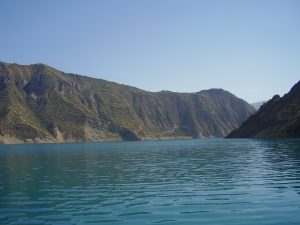Amid a cold snap last week, parts of Tajikistan – including the capital, Dushanbe – were without power. Residents of the capital complained of electricity, heating, and water shut-offs during the three-hour blackout. Meanwhile, some telecommunications services were also down.
A source at the Nurek hydroelectric power station told Asia-Plus, a Tajik media outlet, that the blackout was a result of an accident, but officials have not commented on the situation. Asia-Plus said it was unable to get comments from either the state-run power company Barki Tojik or the government.
Construction of the Nurek dam began in 1961 and its first generator was commissioned in 1972. At present, the dam, with an installed capacity of over 3,000 megawatts, supplies an estimated 50 percent of Tajikistan’s electricity – down from an estimate of 70 percent as recently as 2019.
A rehabilitation project was launched in 2019, financed by the World Bank ($225.7 million), the Asian Infrastructure Investment Bank ($60 million) and the Eurasian Development Bank ($40 million); it is the first major rehabilitation effort at Nurek since 1972. In October 2022, the World Bank celebrated the inauguration of the first rehabilitated unit at the hydroelectric plant and noted that nine units in total are expected to be refurbished.
“Once completed, the rehabilitation will allow the Nurek HPP to increase winter generation by 33 million kWh — which is central to the Government’s efforts to ensure that energy demand can be met even during the coldest months,” a World Bank press release noted.
The World Bank’s investments in Tajikistan’s energy sector stood at around $641 million as of 2022.
Despite those investments, Tajikistan continues to wrestle with winter-time power outages across much of the country’s rural areas. While Dushanbe, and other major cities, have generally been spared regular outages, the same is not true of non-urban communities. And in recent months, Dushanbe has experienced more outages. According to Eurasianet’s reporting, “Under the annually imposed economy regime, which is meant to be ending sometime [in March], households outside the country’s largest urban centers endure blackouts from 8 a.m. to 5 p.m. and then from 10 p.m. to 5 a.m.”
Meanwhile, construction costs at the mighty (and long hyped) Rogun dam have appeared to spiral upward. In 2016, when construction began anew nearly 40 years after the first effort to build a dam at the site, the cost was quoted at $3.9 billion. It was planned then that the first two turbines would be up and running by 2018; the first came online in November 2018 with the second beginning operation in September 2019. Six turbines are expected, but further progress has been scant and costs have soared. As Eurasianet reported last month, Tajik Energy Minister Daler Juma cited the cost at $6.2 billion (down from a June 2022 figure of $8 billion.)
The grand hope is that the rehabilitation of Nurek and the completion of Rogun will not only position Tajikistan to supply sufficient electricity to its own population during the winter but enable the country to increase summertime exports. That vision, however, may be undercut by the impacts of climate change on water levels in the reservoirs necessary to turn the turbines. Hydroelectric power is only as renewable as the water from which it generates electricity.
Tajikistan confronts many of the same issues as neighboring Kyrgyzstan, where water levels at the critical Toktogul reservoir are approaching a dangerous low point. Tajik authorities, however, are less transparent about the situation, as illustrated by the lack of comments on the blackout last week or available information regarding water levels at Nurek.
In the meantime, the Tajik population deals with the lack of electricity and the wintery weather. In late February, a family of six in Dushanbe died of carbon monoxide poisoning. They were heating their home with coal amid an electricity shortage. An unnamed official told RFE/RL at the time, two days before the larger blackout on March 1, that the outages in the capital were tied to a decrease in water levels at Nurek.

































